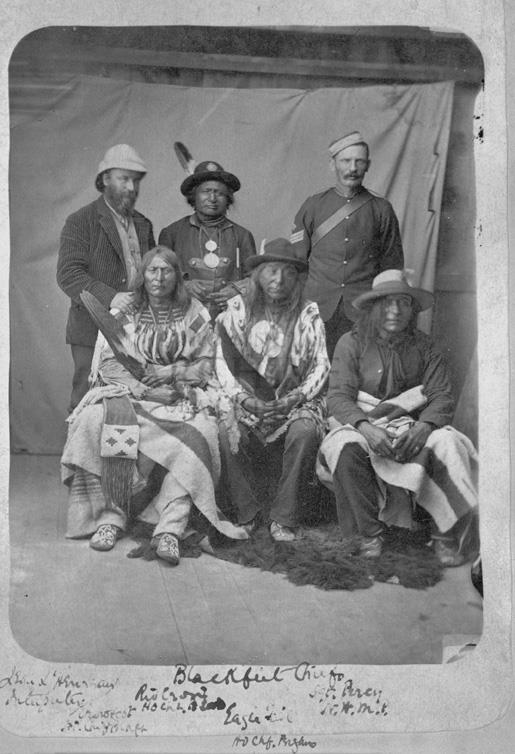 |
| Title: John Le Heureux, Red Crow, Sgt. Percy, Crowfoot, Eagle Tail, and Three Bulls. Provincial Archives of Alberta Number: A16120 |
L'Heureux arises in the history of the Canadian West in 1861, when he was staying at the St. Albert mission (near Fort Edmonton). From the priests' perspective, L'Heureux's term in the region was inglorious. After being discovered engaged in sodomy, he was quickly sent south. The priests arranged for him to head to Montana with a band of Blackfoot. Not one to follow others' plans, L'Heureux was quickly donning a cloak of authority. By wearing a cassock, he told the Blackfoot that he was working for the Oblates, and managed to trick the Jesuits in Montana into believing he was a secular priest.
As Hugh Dempsey describes, L'Heureux found the Blackfoot more understanding that the Euro-Canadians:
Over the next several years L’Heureux lived with the Blackfoot, often wearing a cassock and performing baptisms and marriages. He was despised and vilified by the clergy and fur traders both for being homosexual and for pretending to be a priest. He was also mistrusted because of his complete devotion to the Indians who, he had discovered, did not condemn homosexuality. He took the Blackfoot name of Nio’kskatapi, or Three Persons, after the Holy Trinity. (CDBO)It was perhaps this acceptance by the Blackfoot that made L'Heureux such an advocate for the First Nations of the region. Throughout the 1860s to 1883 he routinely lobbied for help against epidemics, starvation, and the American army. In 1877, at the Treaty No. 7 signing, L'Heureux refused to translate for Lieutenant Governor David Laird as he would be interpreting for Crowfoot and other Blackfoot chiefs. Frank Oliver, noted that L'Heureux, "stood unswervingly with the Indians as an Indian." (Dempsey, CDBO)
L'Heureux worked for the Department of Indian Affairs during the 1880s, but was dismissed in 1891 for favouring the Roman Catholics. His autumn years were spent in Father Lacombe's hermitage at Pincher Creek, and later he moved further into the foothills where he lived in seclusion. In 1912, he was accepted into the Lacombe Home in Midnapore, "still wearing his cassock and clerical collar." (Dempsey, CDBO) In 1919 he passed away and was recorded by the church as a "lay missionary."
Elsewhere Dempsey summarizes L'Heureux's mixed reputation among the principle groups in the early Canadian West. The comments may serve as unfortunate epitaph for a wild and mysterious character who was an outsider to all cultures of the frontier. "Throughout his life he was a controversial figure, despised and distrusted by many fur traders, an asset and embarrassment to the Oblates, and received by the Blackfeet with the mixed emotions they had for crazy people." (Dempsey, Crowfoot: Chief of the Blackfeet, 1988, p. 83)

No comments:
Post a Comment